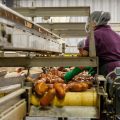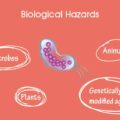Which Action Can Help Minimize Food Safety Risks?
A- cleaning under the fingernails when washing hands
B- washing hands with water only before cutting an apple
C- using a grater to chop vegetables while preparing a meal
D- using the same cutting board to cut meat, green peppers, and onions
The correct answer to the question above is option A: cleaning under the fingernails when washing hands.
One of the biggest causes of food poisoning in the kitchen and at home are hands that are contaminated with harmful bacteria. Kitchen hygiene consultants are mainly concerned with two types of bacteria Escherichia coli and Staphylococcus aureus.
These bacteria are known as indicator organisms that will alert us to unhygienic practices. This is the case because E.coli occurs naturally in the human gut and tells us the possibility of unwashed hands after using the ablution facilities has taken place.
S.aureus can occur naturally in the nasal passages, also indicating unhygienic practices. These bacteria can also occur as a result of handling raw materials or on the skin of a person without harm.
In many countries, it is a requirement to have regular health checks for food handlers to test for a natural S.aureus carrier and other infectious diseases. This is because regular antibiotic treatment would be needed because these bacteria are also heat-stable toxin-producing pathogens.
Why is handwashing important?
Hand washing is vital in preventing contamination of food by food handlers. Harmful bacteria such as E. coli, Salmonella, and Staphylococcus aureus and viruses (e.g. norovirus) present on the hands of food workers are removed by proper handwashing techniques.
How often should food workers wash their hands?
Hands should be washed as often as necessary and always:
- Before starting work
- Before handling cooked or ready-to-eat food
- After handling or preparing raw food
- After handling waste
- After cleaning duties
- After using the toilet
- After blowing the nose, sneezing, or coughing
- After eating drinking or smoking
- After handling money
Is handwashing necessary if gloves are used when handling food?
Proper handwashing is extremely important, whether using gloves or not. If using gloves, hand washing should be carried out before putting gloves on, between glove changes, and after gloves are removed. The problem with the use of gloves is that in situations where the staff are not given proper training in food safety, gloves are often seen as a barrier to food contamination. Staff may then carry out many non-food-related tasks (e.g. handling money, emptying bins, wiping counters) while wearing the same pair of gloves that they then use to prepare food.
When wearing gloves for a prolonged period of time, without frequent changing and hand washing, bacteria on the skin rapidly multiply due to the warm, moist environment created by the gloves. If the gloves tear or are removed and food is handled without handwashing, a high number of bacteria can be transferred to the food.
What is the proper handwashing technique?
Hands should be washed for at least 20 seconds as follows:
Wet hands under warm running water
- Use enough soap to form a good lather
- Rub all parts of hands with soap and water
- Lather for at least 20 seconds, vigorously and thoroughly rubbing all hand surfaces, including the fingertips and thumbs
- Rinse hands thoroughly with running water
- Dry hands thoroughly
How hot should the water be for handwashing?
The temperature of the water is not as important as the technique that is used. However, it is important that the water is not so hot that hands cannot be held under the water for a sufficient length of time to ensure they are properly clean.
Should separate sinks be provided for handwashing?
Yes, a designated sink for handwashing must be provided in food preparation areas. It must be easily accessible, not likely to be obstructed, and located close to the working area. In large kitchens that are sub-divided into different work areas, more than one sink must be provided. Hand wash facilities must also be provided for foodservice and bar staff, where applicable.
What should be provided for washing and drying hands at the hand washing sinks?
There should be an adequate supply of hot and cold running water, non-perfumed soap in appropriate dispensers, and a suitable method of hand drying (e.g. paper towels from a dispenser, hand driers, or cabinet roller towels). Hand driers are not suitable for use in food preparation areas. Check Out This Food Safety Quiz and Answers





